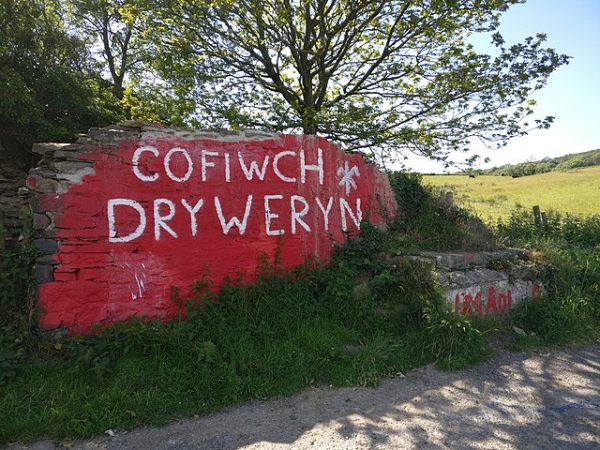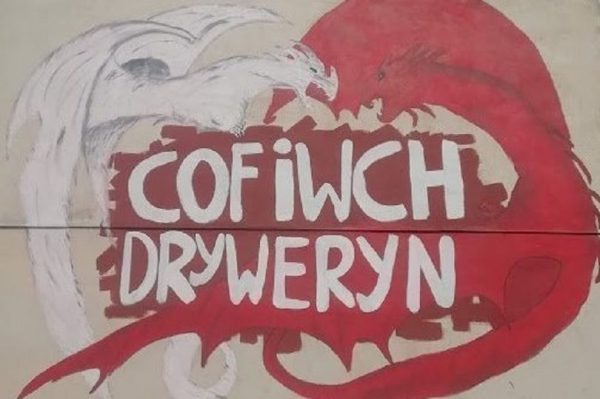In 1965 the village of Capel Celyn in the valley of the Afon Tryweryn valley in Gwynedd was flooded to create Llyn Celyn reservoir to supply water to the towns of Wirral peninsula and the city of Liverpool in England.
Needless to say, this act of colonial vandalism met with almost universal condemnation in Wales, represented a pivotal moment and event in Welsh nationalism and gave a huge boost to the Welsh devolution cause.
In addition, the drowning of the Tryweryn valley had a wide cultural impact.
In response to the impending flooding of the Tryweryn Valley, author Meic Stephens decided to paint “Cofiwch Tryweryn” (sic), Welsh for “Remember Tryweryn“, on a rock. Eventually he settled on the wall of a ruined cottage named Troed-y-Rhiw for his artwork. Because the original Cofiwch Tryweryn is grammatically incorrect, subsequent restorations of the wall have repainted the message correctly as Cofiwch Dryweryn, adding the consonant mutation.

The mural has since gone on to be reproduced on T-shirts, pitchside banners at Welsh international football fixtures and replicated at other sites in Wales.
Which brings us to Maesteg and Bridgend County Borough Council.
Today’s Wales Online reports that Maesteg resident Sian Thomas-Ford’s Cofiwch Dryweryn, painted in 2019, had incurred with displeasure of Bridgend County Borough Council, which, in that accommodating manner peculiar to all local authorities, had ordered the mural’s removal.

Since 2019 the Bridgend mural has undergone some changes. Firstly, the two dragons – one red and one white – of Welsh legend have disappeared, whilst the Welsh independence slogan “Yes Cymru” has been added.
Bridgend Council took the attitude that the mural was an advertisement and notified Ms Thomas-Ford last summer that she could be prosecuted if she did not paint over the mural. Furthermore, the council told Ms Thomas-Ford that their highways department found the mural is a “distraction to drivers”. The council’s planning fees for advertisements range from £120 to £460. Ms Thomas-Ford’s response to the council was defiance, stating she did not intend applying for planning permission because the mural is not an advertisement, but rather a celebration of Welsh history and a reminder of an event that should not be forgotten.
Ms Thomas-Ford told Wales Online that the mural had sparked lots of conversations locally about Welsh history and culture.
Some 3,000 people signed a petition in support of keeping the mural.
The council has now dropped its bureaucratically absurd position of regarding the mural as an advertisement. In a bit of municipal face-saving, a council spokesperson is quoted as saying:
From the council’s perspective, advertising consent is required to protect the householder, but we do not currently intend to take any further action. It remains open to the owner if they wish to regularise the matter.